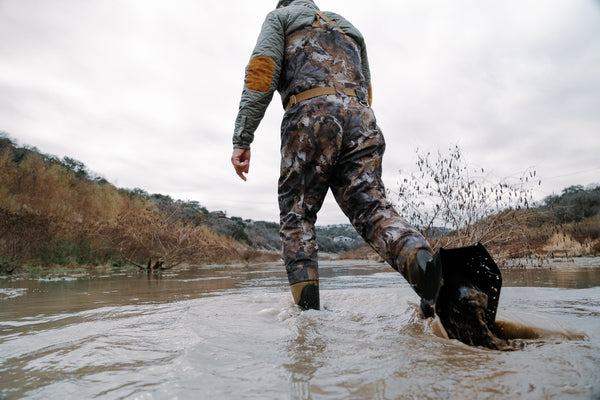
Waterfowl Hunting Gear: A Detailed Guide
Waterfowl hunting isn't just a sport; it's a pursuit that blends skill, timing, and the right gear. This type of hunting has become more gear-driven than ever. From decoys to outerwear, every item you bring into the blind plays a role in your success. Whether you're a seasoned hunter or just starting, understanding the modern landscape of waterfowl hunting equipment is essential.
Waterfowl Hunting Gear List
This guide covers the must-haves, what to look for, and how to choose the right gear for your hunt.
Decoys
A good decoy spread can make or break your hunt. It’s not just about tossing a few plastic ducks into the water; realism matters. Today’s top decoys feature oversized body shapes, lifelike paint finishes, and durable keels that withstand even the roughest, choppiest waters. Mallard decoys remain the go-to for most setups. A 12-pack typically costs between $130 and $160, though savvy hunters know that seasonal sales, especially around Black Friday, can bring those prices down by 20–30%.
For geese and other species, full-body or shell decoys offer more visibility and realism. Budget decoys might suffice, but if you hunt frequently or in challenging environments, premium models pay off in terms of longevity and effectiveness.
Waders
If you're stepping into marshes, flooded timber, or shallow lakes, a solid pair of waders is non-negotiable. Entry-level neoprene waders provide decent insulation and comfort, starting around $290. They’ll keep you warm in cold water, especially if they come with 600g to 1600g insulation in the boots.
On the high end, breathable waders dominate the market. Priced up to $1,000, they offer zip fronts, reinforced knees, and breathable fabrics that keep you dry without sacrificing mobility. For long days in the field, investing in top-tier waders can mean the difference between enduring and enjoying the hunt.
Mudder Boots
Waterfowl hunting often means walking through deep, sticky mud, and regular boots can easily slip or sink. Mudder Boots are made to handle this. Their wide, expandable wings spread your weight out, so you stay steady and don’t sink.
They also have a strong buckle to keep the boots from coming off. At the bottom, small holes let mud and dirt escape as you walk, making each step easier and cleaner.
Outerwear
Waterfowl hunting often means facing wind, rain, and freezing temperatures. A good jacket isn’t just insulation, it is essential for protection. Waterproof parkas and shell jackets are your first line of defense, with prices typically ranging from $180 to $700, depending on materials and features.
Many hunters prefer a layered approach. Fleece-lined jackets and hybrid insulation pieces can be worn under shells for warmth and versatility. These mid-layers often range between $130 and $300. Look for jackets with windproof fabrics, storm flaps, and wader-length cuts if you spend time in deeper water.
Shotguns
When it comes to firepower, the 12-gauge shotgun remains the staple in waterfowl circles. Entry-level pump-action models start around $380 and are perfect for hunters on a budget. Semi-automatic models climb toward $3,000, boasting features like recoil-dampening systems, camo-dipped finishes, and enhanced cycling mechanisms.
The choice between a 3-inch and 3.5-inch chamber depends on your preferred load size and the birds you're chasing. For many, a mid-tier semi-auto strikes the right balance between affordability and performance.
Blind Bags and Storage
You don’t want to be fumbling for shells or gear when the birds are circling. That’s where good storage comes in. Decoy bags range from simple mesh options to more structured, rugged carriers priced between $20 and $100. Blind bags, especially floating models, offer waterproof compartments, durable construction, and easy access to essentials, generally priced from $60 to $160.
Shotgun cases, another field essential, range from $60 to $170 depending on whether you go for soft-sided, hardshell, or floating options.
Layering
Staying warm in the field starts with proper layering. Base layers made from Merino wool or synthetics help regulate your temperature, wick away moisture, and keep you from freezing. These typically range from $60 to $150 and are worth every cent for comfort.
Mid-layers, often made of fleece or grid-knit fabric, provide added insulation without restricting movement. For warm-weather hunts, lightweight performance shirts with UV protection and moisture-wicking fabrics are becoming increasingly popular. These generally cost between $60 and $100.
Accessories
It’s easy to overlook the extras, but smart accessories can seriously improve your hunt. Decoy rigs like Texas and jerk rigs offer a simple setup and retrieval, costing anywhere from $30 to $120. Cold-weather accessories like gloves and beanies now come with waterproofing, insulation, and even touchscreen capability, typically priced between $50 and $140.
If you're hunting with a dog, don’t skip on gear for them. Neoprene vests with chest protection and grab handles, priced around $70, help keep your retriever safe and efficient.
Understanding the Price Landscape
Most hunters can outfit themselves with solid gear in the $100–$300 range per item. Basic gear like decoy bags or gloves costs less, while core pieces like jackets or waders sit in the mid-$200s. Premium gear, such as high-end outerwear or semi-automatic shotguns, can reach $1,000 or more.
That said, seasonal discounts and promotions can bring top-tier gear within reach. Planning your purchases around major sales can help stretch your budget without sacrificing quality.
Final Thoughts: Get the Gear That Works for You
Waterfowl hunting is about more than just showing up; it’s about showing up prepared. With the right gear, your time in the blind becomes more productive, more comfortable, and more enjoyable. Start with the essentials: reliable waders, solid outerwear, and a dependable shotgun. Then, as your skills and preferences evolve, expand your kit with decoys, layering systems, and accessories.
The good news? There’s never been a better time to gear up. With modern advancements and more gear options than ever, waterfowl hunters can tailor their loadout to match their hunt. Take the time to choose wisely and let the birds come to you.




